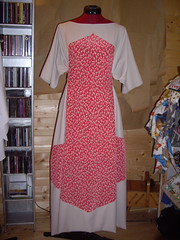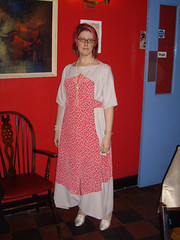I was invited to a 1920s Tea Dance, so of course I took the opportunity to make a 1920s dress!
It’s Folkwear 261, the “Paris Promenade Dress”.
That’s front and back – you can tell the back by the tassels on the ends of the sash. (Look closely – they’re camouflaged, but they are there.)
Folkwear are apparently very accurate with their period sewing patterns, and this one assumed that you weren’t going to be using a sewing machine for anything but the long, straight seams. This meant that it was constructed in such a way that you couldn’t use a sewing machine for anything but the long, straight seams, and so I spent a Very Long Time doing a heck of a lot of hand sewing.
I’m very, very pleased with the work that’s gone into this dress. There was a lot of hand sewing, and the construction was like origami, but I’m (mostly) happy with the results.
I also made a last-minute hat which apparently made me look like some kind of demented floral sous-chef, which wasn’t quite the look I’d been going for. Pretend you didn’t see that, if you like. 😉
Here’s the dress, complete with bad hair moment after I’d decided that I couldn’t tolerate the stupid hat any longer.
That front apron part actually works as one truly ENORMOUS pocket, by the way. (Not all the way down to the point, there’s a seam about half way across the wide part, on the inside. That I sewed by hand. Aargh.)
That poofy bit at the hem is REALLY ANNOYING. Doesn’t do it on the dress form. Doesn’t do it on the coathanger. Doesn’t do it on the ironing board. Put the dress on? Poof. Grrrrr.
The hem is actually on a very deep fold of the fabric, so even though it’s been pressed into place, it’s draping differently because I’m not the same shape as my dress form. I think the best way to fix this is going to be to have someone else pin the hem into place while I’m wearing it, and then I can press the fold in the same place that it’s going to fall when the dress is being worn.
I have to say that the dress was absolutely FABULOUS to wear. I’m not usually a fan of synthetic fabrics, but the main body of the dress is a polyester crepe lightweight suiting, and it flows and drapes absolutely beautifully. Because the sash is also slippery (polyester georgette), you can lift your arms up very easily, and the dress just slides around. So floaty, so comfortable, and very glamorous-feeling.
Possibly also very comfortable because the narrowest part of the dress measures 68″ around, with the widest part clocking in at 84″. (That’s roughly twice as big as me.) I’d been a bit worried that all that fabric might make it look as though I’d gone to a party in a big beige sack, but thankfully that wasn’t the case at all!
I’m half considering making another one, perhaps in black. And without the silly hat.





Yours is the best review I’ve found of this pattern, and I think I’ve finally gotten it figured out. I haven’t decided whether to buy this pattern yet because 1) I know how to make patterns, and 2) I’m not sure it would look good on me because I have a large bust, and it seems this type of style looks better on small-busted forms.
Anyway, could you comment on my theory about the shape of the pattern pieces and answer my questions?
1. The top (dress) is a single layer, with the back and front cut all in one and the neckline cut out of the center.
2. The overdress has a lining that attaches to the top edges of both layers of the “skirt” which is cut double so as to fold at the hem.
3. Does the bottom (single layer) of the overdress attach to the skirt?
4. Is there actually a pocket opening in the overdress?
5. Someone mentioned it is difficult to get the overdress attached to the dress without misshaping it. Is this entirely done by hand, or is it topstitched to the dress?
Thanks for the review and any advice you might have. I have some tissue-weight navy wool that I am considering, with a burgundy acetate ( I think, it’s vintage fabric) crepe overdress, but I do like the idea of using a small print for at least one element of the dress, so I’m not sure. If I do make this dress, I’ll probably figure out a way to make it machine stitchable!
Hi Kristine, thanks for your questions!
1. Yes, that’s right.
2. Yes.
3. Yes – the bottom of the apron is sewn to the skirt in a pointed seam, and the remainder of the skirt is folded to the inside to make its own lining and a folded hem.
4. Yes! It doesn’t go all the way down to the pointed end of the apron – the apron lining has a horizontal seam about half way down the wider part, which the inside of the skirt is sewn to. So about half of the apron effectively makes one huge pocket!
5. This is true, especially if you’re working with a slippery fabric like a crepe, which can shift about a lot at you work. The pattern suggests doing this by hand, which I did, but I think topstitching would help to hold the weight of the top of the apron better.
What I found with this pattern is that the shape of the pieces are simple, but the construction was quite complicated! Because you have several pieces joining in one seam which is completely hidden on the inside of the dress, you have to make sure you do everything in the right order, or it won’t work.
If you use a print for the main body of the dress, you’ll need to add a shoulder seam, so that the print isn’t upside down on the back! The main consideration is to make sure that the fabric drapes really well. The finished width (I made a size M) is 84″, so you need a nice flowing fabric that won’t bunch up too much.
Have fun – I’d love to see another one!
I have made the dress and large busts work with this dress. I did it all on machine. Attaching the bottom was a bit like origami, you are right there. For larger women, it is very slimming. And agree, oh so comfortable. I did mine with a black/white floral pattern and a black apron. Worked out so wonderfully. Sheila